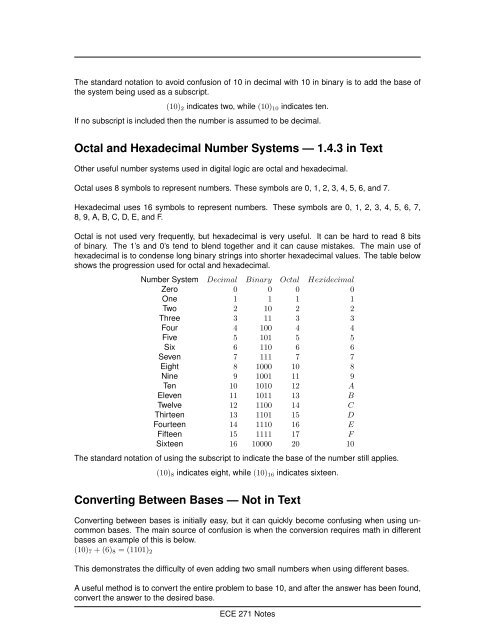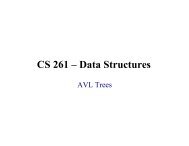Lecture 1: Digital Systems and Number Systems - Classes
Lecture 1: Digital Systems and Number Systems - Classes
Lecture 1: Digital Systems and Number Systems - Classes
You also want an ePaper? Increase the reach of your titles
YUMPU automatically turns print PDFs into web optimized ePapers that Google loves.
The st<strong>and</strong>ard notation to avoid confusion of 10 in decimal with 10 in binary is to add the base of<br />
the system being used as a subscript.<br />
(10) 2 indicates two, while (10) 10 indicates ten.<br />
If no subscript is included then the number is assumed to be decimal.<br />
Octal <strong>and</strong> Hexadecimal <strong>Number</strong> <strong>Systems</strong> — 1.4.3 in Text<br />
Other useful number systems used in digital logic are octal <strong>and</strong> hexadecimal.<br />
Octal uses 8 symbols to represent numbers. These symbols are 0, 1, 2, 3, 4, 5, 6, <strong>and</strong> 7.<br />
Hexadecimal uses 16 symbols to represent numbers. These symbols are 0, 1, 2, 3, 4, 5, 6, 7,<br />
8, 9, A, B, C, D, E, <strong>and</strong> F.<br />
Octal is not used very frequently, but hexadecimal is very useful. It can be hard to read 8 bits<br />
of binary. The 1’s <strong>and</strong> 0’s tend to blend together <strong>and</strong> it can cause mistakes. The main use of<br />
hexadecimal is to condense long binary strings into shorter hexadecimal values. The table below<br />
shows the progression used for octal <strong>and</strong> hexadecimal.<br />
<strong>Number</strong> System Decimal Binary Octal Hexidecimal<br />
Zero 0 0 0 0<br />
One 1 1 1 1<br />
Two 2 10 2 2<br />
Three 3 11 3 3<br />
Four 4 100 4 4<br />
Five 5 101 5 5<br />
Six 6 110 6 6<br />
Seven 7 111 7 7<br />
Eight 8 1000 10 8<br />
Nine 9 1001 11 9<br />
Ten 10 1010 12 A<br />
Eleven 11 1011 13 B<br />
Twelve 12 1100 14 C<br />
Thirteen 13 1101 15 D<br />
Fourteen 14 1110 16 E<br />
Fifteen 15 1111 17 F<br />
Sixteen 16 10000 20 10<br />
The st<strong>and</strong>ard notation of using the subscript to indicate the base of the number still applies.<br />
(10) 8 indicates eight, while (10) 16 indicates sixteen.<br />
Converting Between Bases — Not in Text<br />
Converting between bases is initially easy, but it can quickly become confusing when using uncommon<br />
bases. The main source of confusion is when the conversion requires math in different<br />
bases an example of this is below.<br />
(10) 7 + (6) 8 = (1101) 2<br />
This demonstrates the difficulty of even adding two small numbers when using different bases.<br />
A useful method is to convert the entire problem to base 10, <strong>and</strong> after the answer has been found,<br />
convert the answer to the desired base.<br />
ECE 271 Notes

















